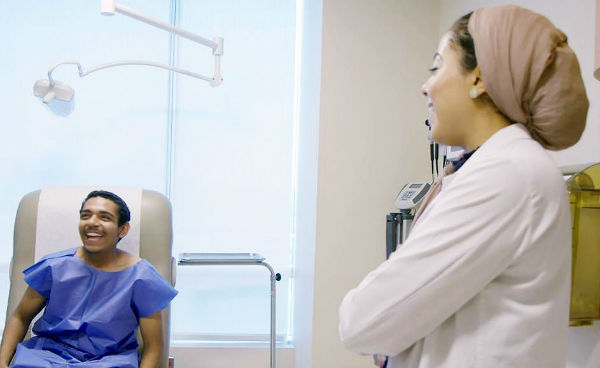
I am a practicing Muslim and have worn a hijab since the eighth grade. When I was in my third year of medical school, with my boards and clinical wards approaching, the idea of wearing a hijab became more anxiety-provoking given the current political climate. I was terrified that a patient would decline my care. Having my desire to help be rejected because of my faith would have been the ultimate slap in the face.
I braced myself for it every day on the wards, but it never happened. As I move forward in my medical career I know I’ve learned much from that experience.
I am not a religious scholar, and I don’t wear the hijab solely out of religious obligation. Rather, I believe that modesty—in the way one treats others, the way one speaks and lastly, how one dresses—is an obligation we have to one another. In my life, the hijab has been a source of strength, a constant reminder of my values and a sign of commitment to my faith.
Wearing it hasn’t always been easy because of how it is sometimes perceived in the world. I have even questioned why I wear it. But beyond the obligation to modesty, my wearing a hijab is a rejection of the idea of judging someone on appearance before understanding that person’s character and mind. It is a choice that I make every day. My hijab is a way of saying that, as a woman, you can unapologetically be whoever you want to be.
My hijab style has evolved over the years. Some days it’s draped across my neck. Other days I adopt the “turban style.” On cold winter days, it’s a beanie. Sometimes a few strands of my hair stick out, and that’s fine. The hijab is meant to empower, not confine, and when I was on the wards, I hoped the patients would see it that way too.
Hijab on the Wards
Especially when my hijab was tied back, I had the privilege of being racially ambiguous in appearance. Latino patients often tried to speak to me in Spanish. When I was on the labor and delivery ward, Hasidic Jews often asked for me to assist in their deliveries. When I told an attending physician that I had studied French in high school, he replied, “Oh, I thought you might be from France.”
Even Muslim patients can’t always put a finger on the country my family came from. Add my Valley Girl voice and my ability to project the kind of confidence usually associated only with a white man, not a brown woman, and I understand why adding the hijab to the mix might throw anyone off. This ambiguity is a privilege I have come to embrace. It doesn’t mean that I am Muslim when it’s convenient. It means that people of all backgrounds can see parts of themselves in me.
The hijab also represents why I chose medicine as a career after my father was diagnosed with glioblastoma. The language and cultural barriers my family faced made me want to help others overcome those hurdles. As medical students, we are taught the concepts of patient autonomy and nonmaleficence. Yet in my family’s culture, complete honesty about a diagnosis is seen as burdensome to those around you. At one point, I was a 17-year-old girl sitting in a corner in a hospital, translating for my mother, trying to bridge those cultural differences and ease her distrust of the medical system. Perhaps the patients I’ve encountered sense that I’ve walked a path similar to theirs and faced painful choices too, even if those choices have been different.
I’ve wondered if that’s why one of my patients confided in me her history of prior abortions after being hospitalized for more than a week. Or why, when I was asked to interview a teenage male as part of an objective structured clinical examination just hours prior to his being discharged, that patient admitted to suffering from depression and being on several medications that needed to be taken orally. My attending physician was shocked to learn this, because this patient had undergone jaw surgery and would not be able to have solids—including pills. We needed to change his prescription immediately. I was grateful for the connection I was able to make with these patients.
Going Beyond Appearances
Of course, there were many days when I just wanted to be a medical student without any preceding adjective or anything drawing extra attention. In response, I pushed myself, wanting to prove that I was there despite all the stereotypes. I never wanted anyone to have a negative impression of Muslims because of my “visible identity.” There is a lot of pressure that comes with trying to be the near-perfect Muslim, Arab American doctor-in-training, and the hijab both added to it and gave me more inspiration.
I don’t want to romanticize the hijab. There is nothing romantic about the Muslim woman’s experience in America. There will always be some struggle associated with my appearance. Would my life be easier if long locks framed my face instead? Probably. Am I frustrated at the end of a long day when my hijab is a mess? Yes. But as many times as I might trip on the rockier road I chose, there’s something that keeps me on it. It’s the honest, human connection I found with my patients during my clinical years, and it has become one of the strongest reasons that I continue to wear the hijab today.

